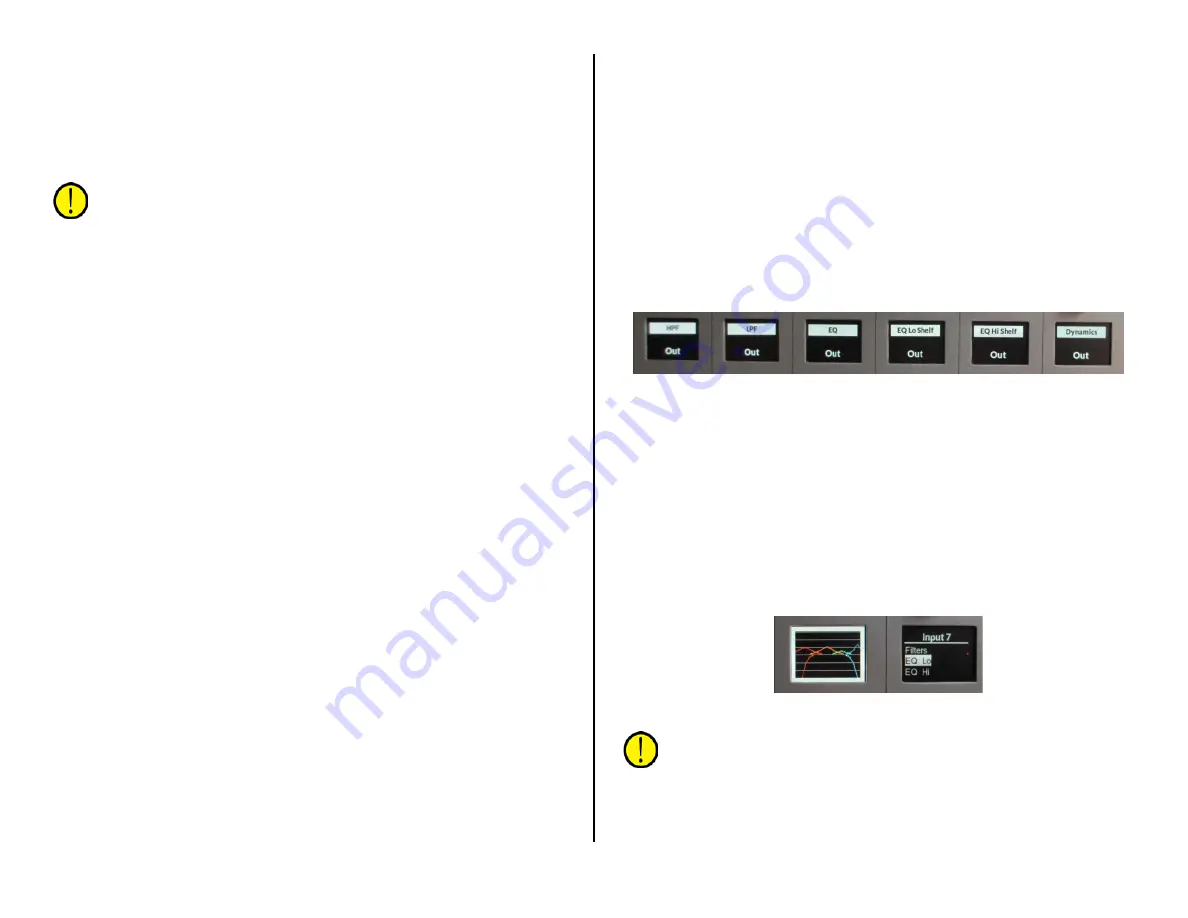
54
If double-clicking the channel encoder shows MODE above the white line
in the channel display then channel Mode control is enabled. You can then
view the next enabled Advanced Channel Feature by double-clicking the
channel encoder again to view Pan (if it is enabled). Double-clicking the
channel encoder again will show the next Feature that’s enabled, and so
on until you double-click the encoder and the normal channel display is
again shown.
Note: When an Advanced Channel Feature is active, and the
channel encoder has not been touched for 20 seconds, the feature
is cancelled and the channel display returns to normal view. When
this occurs the current settings for that feature are auto-saved.
The space above the white line in the normal channel display is available
to show whether any EQ & Dynamics features are active. When EQ is set
in EQ is shown. When the HPF (High Pass Filter) is set in a high pass icon
(
┌
) is shown at the left. When the LPF (Low Pass Filter) is set in a low
pass icon (
┐)
is shown at the right. When Dynamics (Compression and
Expansion) are set in then DYN is shown in the channel display.
Mode
If Mode access is enabled, double-clicking a channel encoder (tapping it
twice quickly) changes that channel’s display to show MODE above the
white line in the channel display.
Rotating the encoder steps through the four audio modes: LEFT channel
only, MONO sum, RIGHT channel only, and STEREO. These are shown in
orange in the channel display. Once the desired mode is displayed double-
click the channel encoder to open the next advanced feature that’s
enabled. If no other features are enabled the channel display returns to its
normal view.
Pan
If Mode is disabled, and Pan is enabled, then double-clicking any channel
encoder (tapping it twice quickly) changes that channel’s display to show
PAN at the top of the channel display. If Mode and Pan are both enabled,
then Pan is accessed from Mode by double-clicking the channel encoder
again to change that channel’s display from Mode to PAN (as shown at the
top of the channel display).
Pan shows an orange/blue bar graph with a white bar to indicate the pan
position in the channel display. Rotating the channel’s encoder moves the
audio in real time (use caution on a live signal) from “Center” toward
being only on the left channel (Left 100) or toward only being on the
right channel (Right 100).
Once the pan is adjusted, double-clicking the channel encoder saves that
setting and either moves to the next enabled channel feature or returns to
the normal channel display if no other channel features are enabled.
EQ & Dynamics
When EQ & Dynamics is enabled, along with Mode and Pan, double-
clicking the channel encoder while Pan is active brings up the EQ &
Dynamics screens which mean eight channel displays change to show its
various screens. If Mode and Pan are both disabled, and EQ & Dynamics is
enabled, double-clicking the channel encoder from the normal display
switches directly to show the eight channels of EQ & Dynamics screens.
When active on channels 1 - 8, the displays on channels 1 - 8 switch to
show the EQ & Dynamics screens. When active on channels 9 - 16, the EQ
& Dynamics screens are shown on the channel 9 – 16 displays. When
active on channels 17 - 28, the EQ & Dynamics screens are shown on the
channel 17 – 24 displays. Figure 4-12 shows the EQ & Dynamics screens
on the first six channels which show the status (In/Out) of the various EQ
& Dynamics features.
Figure 4-12 EQ & Dynamics In/Out Select Screens
The last two EQ & Dynamics screens show an audio graph and the
screen selector to show the various EQ & Dynamics adjustment displays.
Rotate that channel’s encoder (i.e., channel 8, 16, or 24) to move the
highlighted selection up/down through the list switching the EQ &
Dynamics screens displayed on the other seven channel displays.
Figure 4-13 shows the right-most displays when EQ & Dynamics is active
on channel 7. The active channel’s display, regardless of which EQ &
Dynamics screen is being shown, is outlined in white and its channel
number is shown at the top of the screen selector display. In this case, the
white box around the graph display indicates EQ & Dynamics is being set
on channel 7 and the channel 8 encoder selects the adjustment displays.
Figure 4-13 Active Channel Indications
Note: All Advanced Channel Feature settings—on all channels, are
saved as part of a console event. Taking an event will override the
current Advanced Channel Feature settings on all channels that are
off when the event is taken. If you want to preserve any manually-
set channel features, be sure those channels are left turned on
when taking an event. Channels that are turned are not updated
when an event gets taken.
Summary of Contents for EMX
Page 4: ...4 ...
























